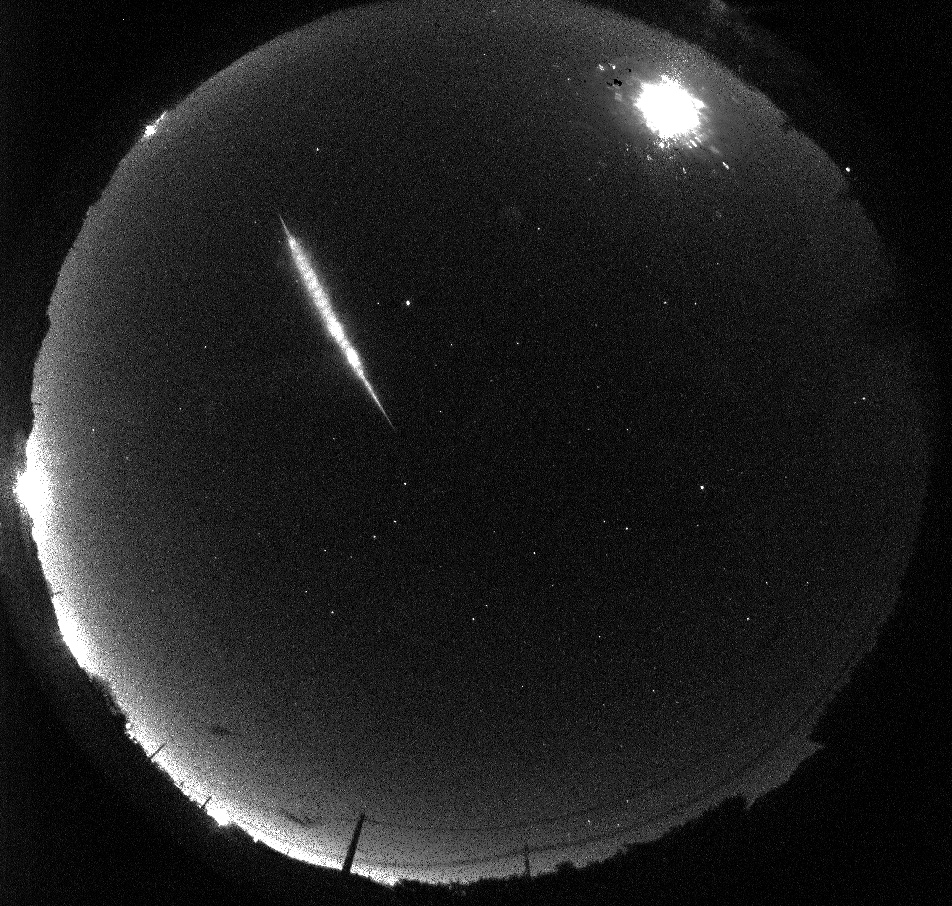 |
Thèse : Méthode d’analyse statistique appliquée au réseau d’observation européen des météores FRIPON |
 |
Résumé :

Cette thèse a pour sujet d'étude l'observation des météores à l'aide du réseau français de caméras FRIPON.
On y aborde toute la chaîne d'analyse des mesures des météores, des images brutes aux orbites. On y développe un estimateur des moindres carrés modifié adapté aux instruments larges et complexes tel qu'un réseau continental de caméras.
Cet estimateur des moindres carrés modifiés est construit pour rendre compte du caractère multi-échelle de FRIPON : de l'échelle des caméras individuelles jusqu'à l'échelle de ce réseau recouvrant l'Europe de Ouest. Il permet de construire un estimateur réaliste à partir des mesures provenant de caméras dont les caractéristiques peuvent être disparates, que ce soit à cause des différences entre les sites d'installation ou des défauts internes de certaines caméras.
L'application de cet estimateur à l'analyse des météores est ensuite discutée.
Nous démontrons notamment que certaines caractéristiques des météores ne sont pas toujours estimables à partir de l'étude de leur mouvement, comme la masse initiale du météoroïde ou encore son enthalpie de destruction.
Un estimateur des moindre carrés de ces caractéristiques n'a alors pas de sens.
Nous proposons un nouveau jeu de paramètres permettant de caractériser un météore et dont les estimateurs des moindres carrés ont une espérance et une variance toujours définies, quelque soit le type de météore et la qualité des mesures.
Par ailleurs, nous étudions les différents biais de mesures pouvant advenir lors de l'observation vidéo de météores. Nous démontrons que les météores les plus rapides présentent systématiquement des mesures dégénérées. Nous montrons que ces dégénérescences non seulement rendent impossible l'estimation de certaines caractéristiques, mais que de plus elles entraînent une surestimation de la vitesse d'entrée de ces météoroïdes dans l'atmosphère.
Cette surestimation des vitesses des météores les plus rapides entraîne l'apparition d'une population de météoroïdes faussement interstellaires.
Nous montrons que, dans le cadre de la campagne d'observation du réseau FRIPON, aucun météoroïde avec une origine interstellaire certaine n'a été observé. De fait, nous remettons en question l'existence d'une nombreuse population de météoroïdes interstellaires que certaines équipes disent observer.
Si les récentes découvertes de 1I/'Oumuamua et de 2I/Borisov attestent de la présence de corps d'origines interstellaires au sein de notre Système solaire, et donc potentiellement de météoroïdes d'origine interstellaire pouvant impacter la Terre, force est de constater que ces objets sont peu nombreux à réellement croiser le chemin de notre planète.
Liens utiles :
|
Paper : Calibration of fish-eye lens and error estimation on fireball trajectories: application to the FRIPON network |
Abstract :
Context: Fireball networks are developing over the whole planet, with the aim of recovering meteorites and at the same time determining their orbits. The ultimate goal of such networks is to identify the parent bodies of meteorite families to achieve this, orbit accuracy is critical. Yet, the determination of an orbit relies on a long and complex reduction process including: (1) astrometry, with heavy distortion for fish-eye lenses, (2) estimation of the external bias on the observation, (3) fit of the trajectory, (4) deceleration model, and (5) actual orbit computation.
Aims: Our goal is to compute accurate trajectories with an estimate of internal and external errors as realistic as possible, taking advantage of the dense observation network FRIPON (Fireball Recovery and InterPlanetary Observation Network), which comprises more than 100 cameras in France and Europe. In particular, we pay special attention to the distortion of images due to fish-eye lenses. In the present paper, we describe the analytical protocol that allows us to compute trajectories and their uncertainties.
Methods: We developed a general distortion model to be used on the FRIPON fish-eye cameras. Such a model needs to be accurate even at low elevation, as most fireball observations are performed low on the horizon. The radial distortion is modelled by a nine-degree odd polynomial, hence by five parameters. In addition, we used three parameters to describe the geometry of the camera and two for non-symmetrical distortion. Lastly, we used a new statistical method taking systematic errors into account, which allows us to compute realistic confidence intervals. We tested our method on a fireball that fell on 2017-08-94 UT 00:06.
Results: The accuracy of our astrometrical model for each camera is 2 arcmin (1σ), but the internal error on the fireball of 2017-08-94 UT 00:06 measurement is 0.7 arcmin (better than 1/10 pixel). We developed a method to estimate the external error considering that each station is independent and found it equal to 0.8 arcmin. Real residuals are coherent with our estimation of internal and external error for each camera, which confirms the internal consistency of our method. We discuss the advantages and disadvantages of this protocol.
|
Paper : FRIPON: a worldwide network to track incoming meteoroids |
Abstract :
Context: Until recently, camera networks designed for monitoring fireballs worldwide were not fully automated, implying that in case of a meteorite fall, the recovery campaign was rarely immediate. This was an important limiting factor as the most fragile - hence precious - meteorites must be recovered rapidly to avoid their alteration.
Aims: The Fireball Recovery and InterPlanetary Observation Network (FRIPON) scientific project was designed to overcome this limitation. This network comprises a fully automated camera and radio network deployed over a significant fraction of western Europe and a small fraction of Canada. As of today, it consists of 150 cameras and 25 European radio receivers and covers an area of about 1.5 × 106 km2.
Methods: The FRIPON network, fully operational since 2018, has been monitoring meteoroid entries since 2016, thereby allowing the characterization of their dynamical and physical properties. In addition, the level of automation of the network makes it possible to trigger a meteorite recovery campaign only a few hours after it reaches the surface of the Earth. Recovery campaigns are only organized for meteorites with final masses estimated of at least 500 g, which is about one event per year in France. No recovery campaign is organized in the case of smaller final masses on the order of 50 to 100 g, which happens about three times a year; instead, the information is delivered to the local media so that it can reach the inhabitants living in the vicinity of the fall.
Results: Nearly 4000 meteoroids have been detected so far and characterized by FRIPON. The distribution of their orbits appears to be bimodal, with a cometary population and a main belt population. Sporadic meteors amount to about 55% of all meteors. A first estimate of the absolute meteoroid flux (mag < -5; meteoroid size ≥~1 cm) amounts to 1250/yr/106 km2. This value is compatible with previous estimates. Finally, the first meteorite was recovered in Italy (Cavezzo, January 2020) thanks to the PRISMA network, a component of the FRIPON science project.
|

